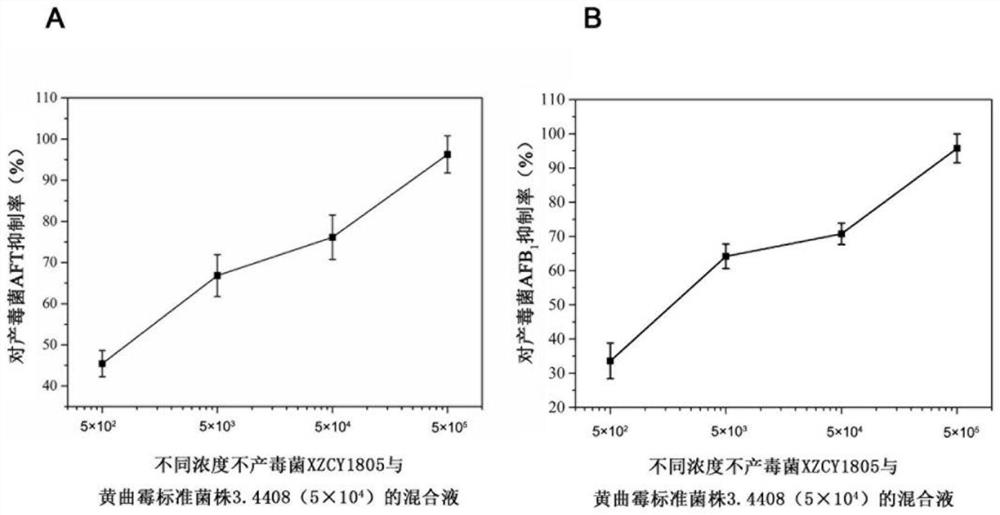Non-toxic aspergillus flavus XZCY1805 and application thereof
A technology of XZCY1805 and Aspergillus flavus strain, applied in the field of microorganisms, can solve problems such as hidden risks, increased cyclopiazonic acid content, mycotoxin contamination, etc., and achieve the effects of high safety, strong competitive inhibition ability, and strong competitive advantage
- Summary
- Abstract
- Description
- Claims
- Application Information
AI Technical Summary
Problems solved by technology
Method used
Image
Examples
Embodiment 1
[0029] Example 1: Isolation, purification and identification of bacterial strain XZCY1805
[0030] More than 2,000 peanut and soil samples were collected from the main peanut-producing areas in Northeast China, North China, Yangtze River Basin and South China, and 1,600 strains of Aspergillus flavus were obtained through separation, purification and identification; 97 strains were selected after the aflatoxin-producing ability of the strains was determined. Non-toxin-producing Aspergillus flavus (mainly isolated from 15 peanut planting areas including Henan, Shandong, Hubei, Jiangxi, and Tibet), the competition inhibition effect research and the evaluation of toxin-producing ability were carried out: co-tested with the toxin-producing standard strain 3.4408 on peanut powder. After cultivation and evaluation of toxin-producing inhibitory effects, 11 strains with significant inhibitory effect on toxigenic Aspergillus flavus were initially screened out; An, Tibet Chayu, Hubei Hon...
Embodiment 2
[0050] Example 2: Analysis of the toxin production of bacterial strain XZCY1805
[0051] 1. Strain toxin-producing culture
[0052] The non-toxigenic Aspergillus flavus strain XZCY1805 was inoculated on DG-18 solid medium for activation. After cultivating for 5 days at 28±1°C in the dark, the Aspergillus flavus conidia on the plate were washed with sterilized 0.1% Tween 80 to obtain a spore suspension. Determine the concentration of the spore suspension with a hemocytometer. Get a certain amount of spore liquid and inject in the Erlenmeyer flask that sterilized 30ml liquid Sabouraud medium is housed, make its final concentration be 4 * 10 5 pieces / ml. Place the Erlenmeyer flask on a shaker at 28±1°C, 200rpm in the dark.
[0053] 2. Determination of strain toxin content
[0054] After 5 days, use sterilized gauze to filter the mycelial culture solution, discard the mycelium ball, collect the toxin-producing culture solution and store it in a centrifuge tube, let it stand f...
Embodiment 3
[0062] Embodiment 3: the inhibitory effect of bacterial strain XZCY1805 on toxin-producing Aspergillus flavus on peanut powder
[0063] 1. Preparation of spore suspension
[0064] The non-toxigenic Aspergillus flavus strain XZCY1805, the toxigenic Aspergillus flavus standard strain 3.4408, and the toxigenic Aspergillus flavus isolated from different regions are numbered SCPA-32-12 (Pengan, Sichuan), XZCY- 24-6 (Chayu, Tibet), LNFX-25-1 (Fuxin, Liaoning), HBHA-129-1 (Hong'an, Hubei), HBYL-12-7 (Yangluo, Hubei), HBTS-94-2 (Tangshan, Hebei) and JXZS-118-9 (Jiangxi camphor tree) were respectively inoculated in DG-18 solid medium for activation. After culturing for 5 days at 28±1° C. in the dark, wash the conidia of Aspergillus flavus on the plate with 0.1% Tween 80 that has been sterilized and put them in a 10 ml centrifuge tube to obtain a spore suspension. Determine the concentration of the spore suspension with a hemocytometer under a microscope, and dilute the spore concentr...
PUM
 Login to View More
Login to View More Abstract
Description
Claims
Application Information
 Login to View More
Login to View More - R&D
- Intellectual Property
- Life Sciences
- Materials
- Tech Scout
- Unparalleled Data Quality
- Higher Quality Content
- 60% Fewer Hallucinations
Browse by: Latest US Patents, China's latest patents, Technical Efficacy Thesaurus, Application Domain, Technology Topic, Popular Technical Reports.
© 2025 PatSnap. All rights reserved.Legal|Privacy policy|Modern Slavery Act Transparency Statement|Sitemap|About US| Contact US: help@patsnap.com



